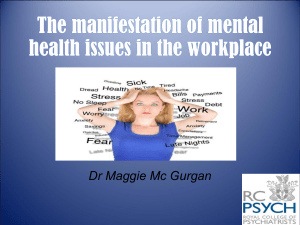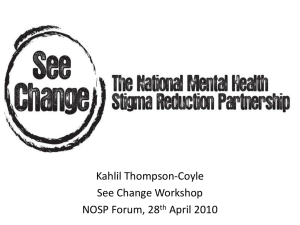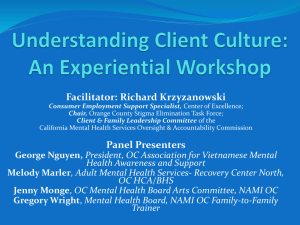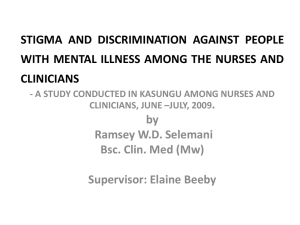We adopted the idea that stigmatizing attitudes can
advertisement
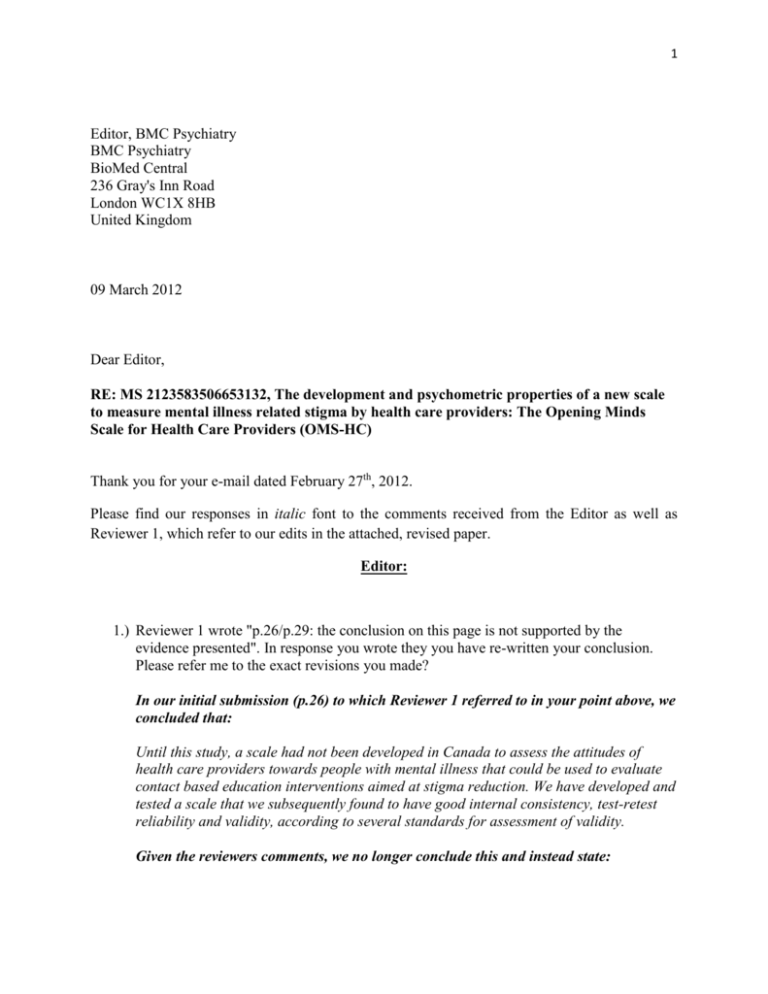
1 Editor, BMC Psychiatry BMC Psychiatry BioMed Central 236 Gray's Inn Road London WC1X 8HB United Kingdom 09 March 2012 Dear Editor, RE: MS 2123583506653132, The development and psychometric properties of a new scale to measure mental illness related stigma by health care providers: The Opening Minds Scale for Health Care Providers (OMS-HC) Thank you for your e-mail dated February 27th, 2012. Please find our responses in italic font to the comments received from the Editor as well as Reviewer 1, which refer to our edits in the attached, revised paper. Editor: 1.) Reviewer 1 wrote "p.26/p.29: the conclusion on this page is not supported by the evidence presented". In response you wrote they you have re-written your conclusion. Please refer me to the exact revisions you made? In our initial submission (p.26) to which Reviewer 1 referred to in your point above, we concluded that: Until this study, a scale had not been developed in Canada to assess the attitudes of health care providers towards people with mental illness that could be used to evaluate contact based education interventions aimed at stigma reduction. We have developed and tested a scale that we subsequently found to have good internal consistency, test-retest reliability and validity, according to several standards for assessment of validity. Given the reviewers comments, we no longer conclude this and instead state: 2 Until this study, a scale had not been developed in Canada to assess the attitudes of health care providers towards people with mental illness. We have developed and tested a scale that we subsequently found to have good internal consistency and adequate testretest reliability during its testing phase. The development of the scale was guided by the tri-partite model of stigma arising from literature reviews focussing on the stigma and how attitudes towards people with mental illness can be measured. We chose to adopt the tri-partite model because this allows for the measurement of clear outcomes such as attitudes which can be measured using the various dimensions of stigma. In our initial submission (p.29) to which Reviewer 1 referred to in your point above, we concluded that: This study shows that the OMS-HC has validity and high reliability among health care providers. This questionnaire can be used to help support anti-stigma interventions by providing sound evaluation data that can help add to the evidence base of stigma reduction activities aimed at health care providers. Given the reviewers comments, we no longer conclude this and instead state: The OMS–HC provides a good basis for further validation as well as a tool that could be used in the evaluation of programs aimed at reducing mental illness related stigma by health care providers. Future research and testing is required for the OMS-HC pertaining to additional items and other variables that may influence responses of health care providers such as demographic variables. The OMS-HC incorporates various dimensions of stigma with a modest amount of items that can be used with busy health care providers. While this project is supported by a national commission, it may have international applicability. We also included in the discussion of our resubmission, The total scores were slightly higher in the 18-25 age group, those in the physician/medical student group and those in Alberta. This requires further exploration and future research can look into closely examining other variables that may influence scores on the OMS-HC such as socio-demographic variables. The factor analysis showed two subscales which measured attitudes towards people with mental illness using the various dimensions of stigma and attitudes towards disclosure and help seeking. While the 12-item scale accounts for only 45% of the variance, this scale is succinct in its number of items which would offset response burden and increase the feasibility of its use in busy health care providers. Future research could also examine testing more items along with those tested in this study to determine if these change the variance accounted for by the two factors or if other factors emerge with sufficient items for additional subscales. Factor analysis in each health care provider group may also provide insight into subscales which may be unique to certain health care provider groups. 3 We adopted the idea that stigmatizing attitudes can also be measured in the form of disclosing whether one has a mental illness and/or seeking help for it, because self stigma may also be an indicator of mental illness related stigma [24, 25]. Likewise, those who would disclose that they had a mental illness may not think that mental illness is something to be ashamed of and may therefore be less stigmatizing to other people with mental illness. In support of the literature that supports self stigma as distinct from holding stigmatizing attitudes towards people with mental illness [25], we found that while health care provider’s attitudes towards disclosure were related to their attitudes towards people of mental illness, there was only a moderate correlation between these two constructs. Evidence for this was also shown by our factor analysis which yielded a two factor solution for the OMS-HC in which we had a 7 item subscale measuring attitudes towards people with mental illness and a 5 item subscale measuring attitudes towards disclosure of a mental illness. As such, the overall scale should be used with caution given the relatively low between factor correlation. Nonetheless, there is a possibility that OMS-HC may behave differently in different groups of health care providers so we advise using the overall scale as well as subscale scores to gain further insight into participant responses. Attitudes towards disclosure and help seeking are important to measure in health care providers as this provides an indication of the stigma that they believe exists due to having a mental illness and how this would impact seeking help. As health care providers are not immune to mental illness themselves, this is an important dimension of stigma to measure in relation to health care provider well being [53]. 2.) Please present a theoretical discussion / explanation now with the new factor analysis there are two factors rather than one. We have now removed the following from our discussion: The total scores of these subscales were moderately correlated and provided evidence that attitudes towards people with mental illness are a different, but not unrelated, dimension of stigma than attitudes towards disclosure of a mental illness or seeking help. These are both important indicators of stigma because attitudes toward people with mental illness provide information about various dimensions of stigma such as whether health care providers desire social distance, are likely to believe that physical symptoms are due to one’s mental illness as well as indicate emotional reactions towards people with mental illness which may inhibit the quality of care received by the person with mental illness. Instead, we have included the following to our discussion on page 29 (as already described above in point 1), 4 We adopted the idea that stigmatizing attitudes can also be measured in the form of disclosing whether one has a mental illness and/or seeking help for it, because self stigma may also be an indicator of mental illness related stigma [24, 25]. Likewise, those who would disclose that they had a mental illness may not think that mental illness is something to be ashamed of and may therefore be less stigmatizing to other people with mental illness. In support of the literature that supports self stigma as distinct from holding stigmatizing attitudes towards people with mental illness [25], we found that while health care provider’s attitudes towards disclosure were related to their attitudes towards people of mental illness, there was only a moderate correlation between these two constructs. Evidence for this was also shown by our factor analysis which yielded a two factor solution for the OMS-HC in which we had a 7 item subscale measuring attitudes towards people with mental illness and a 5 item subscale measuring attitudes towards disclosure of a mental illness. As such, the overall scale should be used with caution given the relatively low between factor correlation. Nonetheless, there is a possibility that OMS-HC may behave differently in different groups of health care providers so we advise using the overall scale as well as subscale scores to gain further insight into participant responses. 3.) Please provide information about the sample of medical students (even if only briefly due to this being apparently a subject of a different article). We have now included the following in the paper regarding the medical students on pg.22: These 2nd year medical students (n=112) were recruited as part of another study which involved the evaluation of an educational intervention aimed at reducing stigma and will be described elsewhere. The medical students completed the 20-item OM-HC as a baseline assessment prior to a psychiatry course. The Cronbach’s alpha reliabilities for the medical student sample remained internally consistent (0.78 for the 20-item scale and 0.71 for the 12 item scale) and the subscales were responsive to change. 4.) Please make the following formatting changes during revision of your manuscript. Ensuring that the manuscript meets the journal’s manuscript structure will help to speed the production process if your manuscript is accepted for publication: - Title page: Please include a title page in the manuscript file. This should contain; Title, Author list, Affiliations (department names, institution name, street name, city, zip code, country), email addresses. The author list and email addresses must be identical in the manuscript file and on the submission system, and it must be clear which affiliation pertains to each author. We have checked our title page and it has been formatted according to the journal’s structure. 5 - Structure: Please check the instructions for authors on the journal website to ensure that your manuscript follows the correct structure for this journal and article type. We have checked the structure and it has been formatted correctly. - Tables: Please ensure that the order in which your tables are cited is the same as the order in which they are provided. Every table must be cited in the text, using Arabic numerals. Please do not use ranges when listing tables. Tables must not be subdivided, or contain tables within tables. Please note that we are unable to display vertical lines or text within tables, no display merged cells: please relayout your table without these elements. Tables should be formatted using the Table tool in your word processor. Please ensure the table title is above the table and the legend is below the table. For more information, see the instructions for authors on the journal website. We have ensured our tables have been formatted correctly. Reviewer 1: Minor Essential Revisions 1.) p.5, line 4-5: The definition of stigma used is very old fashioned, portraying stigma as an ‘attribute’ which suggests that stigma is a static phenomenon, while most current definitions (e.g. Link & Phelan, which authors elaborate on further down, or Weiss & Ramakrishna) emphasize its dynamic nature. We have now removed this definition and the paragraph now reads: Evidence for an association between various dimensions of stigma is either lacking or largely inconsistent. For example, perceived stigma has been found to be unrelated to help seeking in some studies [13, 14]. It must also be noted that most of the models that currently describe the dimensions related to mental illness stigma are based on individual-level rather than a sociological-level of structural indicators of stigma which can occur at the institutional or government level. For the purposes of this paper, we will focus on individual level of stigma, specifically in health care providers. We also now state that stigma is dynamic in the following paragraph where we state: 6 Stigma has been criticized as being too vaguely defined and individually focused [15] and thus existing models have defined stigma as a dynamic interrelationship of components. This interrelationship involves cognitive, affective and behavioural components. In order to understand and measure stigma it is important to conceptualize the term within a more detailed model. 2.) p.6, 3rd para: ‘problem of knowledge’ – this is not always ignorance or misinformation, but may simply be different belief systems, such as religious beliefs, as are held by the majority of the world’s population. We have now changed this paragraph to read the following: A final conceptualization of stigma is the tri-partite model, which proposes that stigma is an overarching term including three core elements: knowledge (misinformation/ differences in understanding due to culture or religion), attitudes (prejudice) and behaviour (discrimination) [17]. Discretionary Revisions 3.) The authors might still consider adding results for floor and ceiling effects of the subscales, as well as the overall scale. We have now added the following to the Results section on page 18. The mean total score for the 20 item scale for all health care providers (see Table 1) was 57.5 (95% C.I. 57.2 – 57.9). Scores ranged from 41.0 to 96.0 and the standard deviation was 4.8. The mean total score for the 12 item scale was 27.0 (95% C.I. 26.7 - 27.4), scores ranged from 16.0 to 67.0 and the standard deviation was 5.0. The mean total score for the attitudes of healthcare providers towards people with mental illness subscale was 12.1 (95% C.I. 11.9 to 12.4) and for disclosure was 15.0 (95% C.I. 14.8 to 15.2). Scores ranged from 7.0 to 35.0 (SD = 3.6) for the attitudes of healthcare providers towards people with mental illness and from 8.0 to 23.0 (SD = 2.5) for attitudes towards disclosure. 4.) In light of the two-factor structure found and the relatively low between-factor correlation, a remark about whether the overall scale score should or should not be used may be helpful to readers. We now state the following on page 29: As such, the overall scale should be used with caution given the relatively low between factor correlation. Nonetheless, there is a possibility that OMS-HC may behave differently in different groups of health care providers so we advise using the overall 7 scale as well as subscale scores to gain further insight into participant responses. Attitudes towards disclosure and help seeking are important to measure in health care providers as this provides an indication of the stigma that they believe exists due to having a mental illness and how this would impact seeking help. As health care providers are not immune to mental illness themselves, this is an important dimension of stigma to measure in relation to health care provider well being [53]. 5.) The section on future research could include a few specific suggestions regarding further development of the instrument, such as determining the Minimally Important Change, Responsiveness, and Smallest Detectable Difference. We now state on page 30: Further research in determining minimally important change (MIC) [56] (the meaning of changes in scores on the OMS-HC over time) is also warranted. This would provide valuable information to detect clinically important changes also known as the responsiveness of an instrument which is an aspect of validity [22]. We sincerely hope that we have fully responded to the points raised and that BMC Psychiatry will publish our article. Sincerely, Aliya Kassam, PhD (Corresponding Author)


